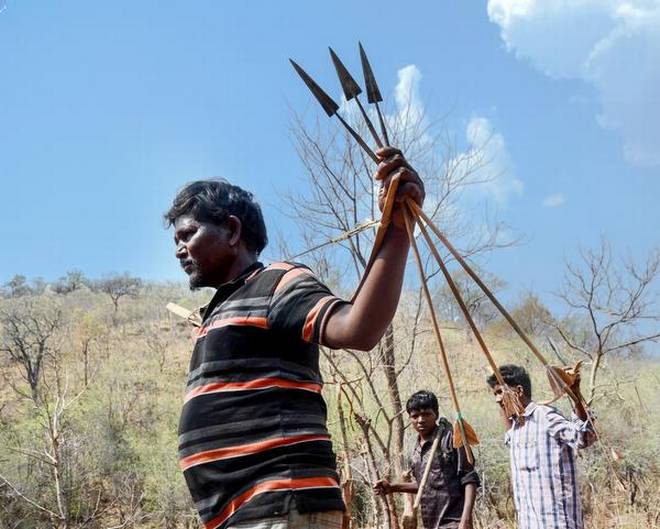In India, where tigers are neighbours

This feel-good start to a May 11 news story by The Hans India gets better; Chenchu members will teach visitors to Nallamala Jungle Camp all about mountain climbing and the forest environment.
Nallamala Jungle Camp is described as comprising “four semi-permanent cottages, six semi-permanent tented accommodation cottages, reception, a yoga centre, a library and dormitory” and also a “facility for showing wild animals to the tourists”.
Krishnamurthy also announced at the inauguration that the Chenchu community would receive permanent housing, loans, and “highways”. And he praised Andhra Pradesh state for providing the Chenchu with “education, rations, and medical care”.
However, it is then reported that the Chenchu appealed to Krishnamurthy for better remuneration of “protection watchers”; “demanded” to be offered the jobs generated by Nallamala Jungle Camp; and “complained” that they aren’t benefiting from the schemes being implemented by the “Integrated Tribal Development Authority”. (Integrated Tribal Development Projects/Agencies are described, unclearly, here.)
There had to be a lot more to this story. And there is.
It turns out the star animal attraction of Nallamala is the tiger, which roams the 3,728-sq. km Nagarjunasagar Srisailam Tiger Reserve (NSTR), India’s largest tiger reserve.
And it turns out the Chenchu “protection watchers” watch tigers; they protect tigers from poaching.
Despite this, according to The Hindu in a May 6 feature story, the Chenchu may no longer have any right to call the Nallamala forest home after a National Tiger Conservation Authority (NCTA) order of March 28 “stripped them of their rights” to “fortify” the NSTR.
With tigers as neighbours who needs wolves at the door?
The order of March 28 reads: “in the absence of guidelines for notification of critical wildlife habitats, no rights shall be conferred in Critical Tiger Habitats (CTH) which is notified under section 38 V (4) (i), of the Wild Life (Protection) Act, 1972.”
The Hindu interprets this to mean that the Chenchu people may no longer have any right to claim Nallamala as their home.
“It also means living in a red zone of man-animal conflict with an inviolate space for the tiger and virtually no place for Chenchus who ironically are counted among the oldest aboriginals of south India and have lived in the Nallamala hill range for hundreds of years,” the newspaper continues.
Dasari Bayanna, a Chenchu tribesman, said: “We have lived in the forests for generations. Show us one example of a Chenchu killing a tiger. In fact, we protect them from poachers. Nor were there many cases of tigers attacking us. Our paths cross but we respect each other. We share the resources.
“But the Forest Department treats us as enemies of the tiger and wildlife and not as protectors. They want to relocate us in faraway plains where we will be like fish out of water. Neither do we have the skills to cope in the plains nor can we return to the forest. We will simply wilt away.”
NSTR Field Director S Sravanan denied coercion: “It may just be their fears. We are not forcing any Chenchu even out of the core area. There is a process and a monetary package for relocation and we give options to them. And it is purely voluntary and only after all Chenchus in a particular gudem (village) have given their consent.”
Sravanan added: “There is no conflict between tiger protection and Chenchus in NSTR. Chenchus live in coexistence here and in fact we deploy 200 Chenchus as tiger protection watchers all round the year and 200 more as forest fire watchers for six months.”
“It’s a con, and it’ll harm the environment”
Survival International is a “global movement for tribal peoples’ rights”.
In a February 2017 Survival International report on the “brutal eviction” of the Baiga people from Rajak village in Achanakmar tiger reserve, Survival’s Director Stephen Corry said: “India’s forests are still being destroyed by industrial “development” and tigers are still being poached.
“But forest officials choose to bully tribal people and throw them off their land. It’s a con, and it’ll harm the environment.
“It’s time the big conservation organisations condemned these fake “voluntary” relocations and admitted what they really are, illegal evictions that lead directly to the destruction of entire peoples.”

“The devastating decline in Indian tiger numbers was mostly caused by colonial and elite hunting rather than by tribal peoples — who have lived alongside tigers for millennia.” — Survival International
So where does the truth lie? Somewhere in the middle?
What should a prospective tourism supply chain partner of a project like Nallamala Jungle Camp do, if anything?
If you have some ideas, please share them here.
Related posts





